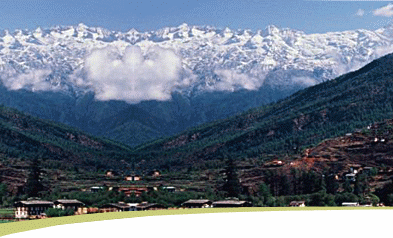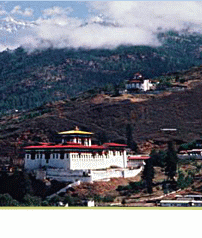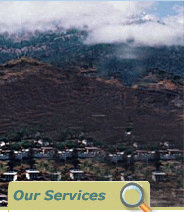| The modern
capital of Bhutan lies at an elevation of 2300m in a valley
traversed by the Wang Chu (river). Tashichho dzong the main
Secretariat building which houses the throne room of His Majesty
and a summer residence of the central monk body. Although
not what one expects from a capital city, Thimphu is a fitting
and lively place. Home to civil servants, expatriates and
the monk body, Thimphu maintains a strong national character
in its architectural style. It is also an ideal spot for day
walks. Phajoding monastery is a 4 hrs hike from the motithang
area. Tango & Cheri monasteries are also another ¾
hrs hike from the capital or all the way to the top of telegraph
hill where thousands of prayer flags obscure the view over
Thimphu.
Memorial Chorten: this stupa was built in
1974 in the memory of the late third King Jigme Dorji Wangchuk.
The paintings and images inside the monument provide a rare
sight into Buddhist philosophy.
Tashichho Dzong: was initially built in
the 17th century, was rebuilt in early 1960s by the third
King Jigme Dorji Wangchuk. Tashichho Dzong houses the main
Secretariat building and the central monk body. It is open
to visitors during Thimphu festival and when the monk body
moves to their winter home in Punakha.
Changangkha temple: built in the 15th century
by lama Phajo Drigom lies on a hill top commanding the Thimphu
valley. The temple has very old scriptures and Thankhas. The
main deity of the temple is Avalokiteshvara, God of compassion.
Simtokha Dzong: the oldest dzong in the
country stands on a lofty ridge at the end of valley. It was
built in 1627 – 1629 and now houses the school for Buddhist
studies. All the Bhutanese language teachers pass out from
this university.
Indigenous hospital: Since Bhutan has its
own brand of Himalayan medicine the Government has given equal
emphasis to both allopathic and traditional medicines. The
rich herbal medicine is prepared here. The old art healing
like acupuncture is still practiced.
National Library: the history of Bhutan
lies imprinted in archaic texts which are preserved at the
National Library. Besides thousands of manuscripts and ancient
texts the library also has modern academic books and printing
blocks for prayer flags.
Painting school: where young children learn
the ancient art of paintings. One can actually see students
at work. Education is free for the students since the government
wants to attract more students. These children after passing
out they are distributed to different districts to apply the
same art of traditional paintings in these areas which is
one reason that the Bhutanese houses have almost the same
type of colour & design.
Vegetable market: Every Saturday & Sunday
most of the Thimphu’s population and many valley dwellers
congregate on the banks of the river where the weekend market
is held. This is the only time in the week when fresh vegetables
are available and Saturday mornings are a hive of activity. |






